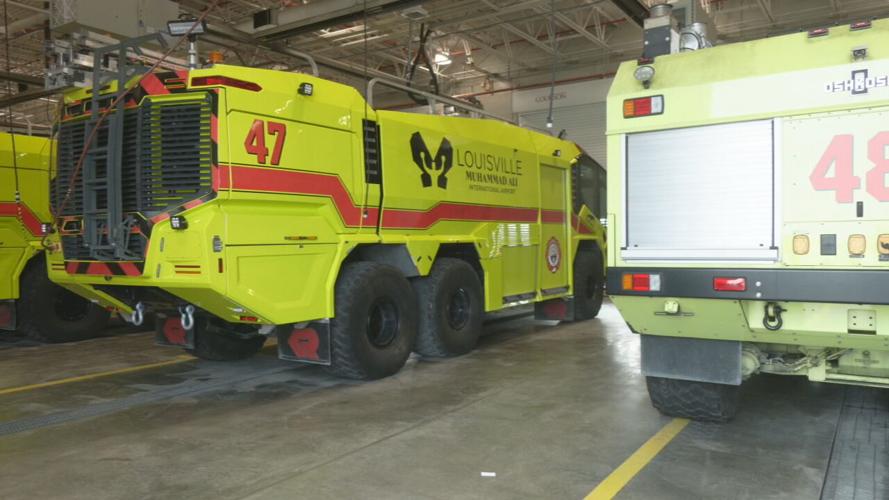LOUISVILLE, Ky. (WDRB) — Weeks after a UPS plane crashed near Louisville Muhammad Ali International Airport, airport firefighters offered a rare look inside the highly specialized emergency response that unfolded in the minutes after the aircraft went down.
Chief Joshua Grimes, who has served with the Louisville Airport Authority for 20 years, said the crash was unlike anything he had ever experienced.
“This is definitely the worst incident I've ever responded to in my 30 years,” Grimes said.
The crash happened earlier this month when Flight 2976 caught fire on the runway, sending thick black smoke into the sky and triggering an all-hands response from airport firefighters, the Kentucky Air National Guard and the Louisville Fire Department. WDRB News drone video later showed charred wreckage and burned-out debris scattered across the area.
Inside the airport firehouse Monday, Chief Grimes walked WDRB through the specialized trucks and tactics airport crews used that day. Each green “ARFF” truck — short for Aircraft Rescue and Firefighting — carries thousands of gallons of water, firefighting foam and dry chemical agents.
Unlike city fire engines, which must stop before engaging hoses, these rigs can “pump and roll,” allowing firefighters to attack flames while the vehicle is still moving.
“City fire trucks have to park and fight a fire,” Grimes said. “These trucks are designed to drive and pump at the same time.”
The airport’s ARFF trucks carry 3,000 gallons of water, more than 400 gallons of firefighting foam and dry chemical powder used to smother jet-fuel fires — the same type of flames crews encountered the morning of the crash.
According to Grimes, flames, burning oil, explosive debris and fallen power lines created dangerous obstacles as firefighters pushed toward the wreckage. At one point, crews were forced to disconnect hoses and reposition equipment to avoid becoming trapped in burning pools of fuel.
Airport fire crews train daily, year-round, and had completed a full-scale exercise involving the Air National Guard just two weeks before the crash. That training, Grimes said, directly supported the massive multi-agency response that morning.
“All three of our agencies arrived at the same time and operated on scene until the next morning,” he said.
Assistant Chief Kyle Miller of the Kentucky Air National Guard said his team deployed immediately when the “Alert 3” call sounded — the designation for an aircraft accident.
“Once they called out Alert 3, we know that’s a plane crash,” Miller said. “As soon as we exited the apparatus bay, you could see the plume of smoke.”
Miller said his job was to supply water to the massive crash trucks battling heavy black smoke and flames that shot 100 to 200 feet into the air. He described the scene as chaotic, fueled by large amounts of jet fuel and burning oil.
“Training just really kicked in,” he said. “You have a job, and whatever you’re told to do, you do it.”
Grimes said the immediate firefighting effort has now concluded, and the site has shifted to environmental cleanup and investigation. But the crash — and the danger his firefighters faced — remains deeply felt inside the airport’s rescue command.
“We’re the subject matter experts in aircraft emergencies,” Grimes said. “We train for this every single day to make sure we’re prepared for anything.”
More Coverage:
Louisville business owner remembers employees, customers killed in UPS plane crash
UPS plane that crashed in Louisville showed 'fatigue cracks' and 'overstress failure,' NTSB finds
Lawsuit accuses UPS, General Electric and Boeing of negligence in fatal plane crash in Louisville
Louisville community gathers at Waterfront Park to honor victims of UPS Flight 2976
All 14 victims of deadly UPS plane crash identified by Louisville coroner
2 weeks after Louisville's fatal UPS crash, here's what happened and what comes next
3 employees missing from auto parts business after UPS plane crashed into building
Louisville Orchestra performance honors UPS plane crash victims, heals community through music
Copyright 2025 WDRB Media. All Rights Reserved.















